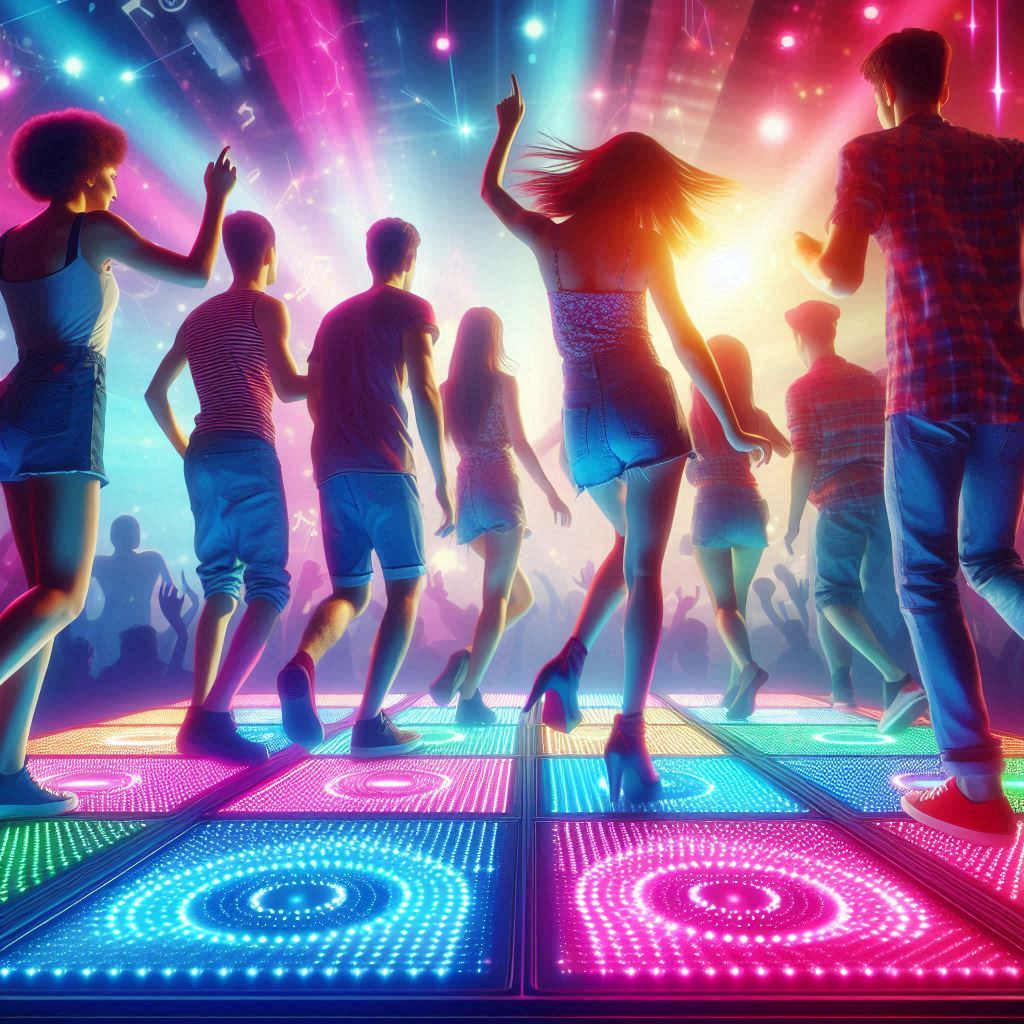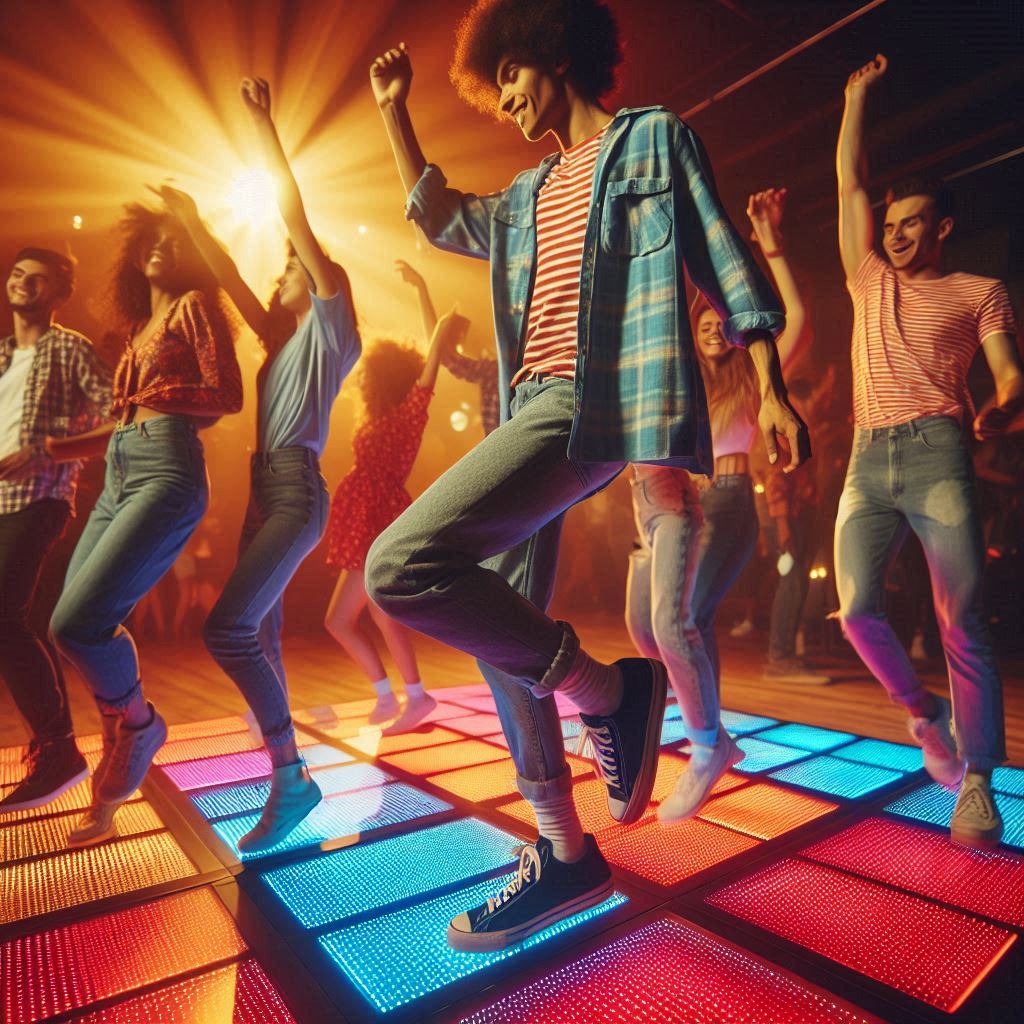Imagine walking into a nightclub where your dance moves don’t just elevate the vibe but also generate electricity. These floors can capture the energy from dancers’ movements and convert it into usable electricity. This innovation holds the promise of revolutionizing the way we think about sustainable nightlife.
So what are kinetic dance floors? This technique enables certain materials to produce an electrical charge when subjected to mechanical strain. When you dance, jump, or even walk on these piezoelectric floors, the pressure generates electricity. This captured energy can then be used to power the venue or even fed back into the grid.
How Kinetic Dance Floors Work
 Kinetic dance floors operate on the ingenious principle of piezoelectricity. This phenomenon occurs in certain materials like quartz or engineered ceramics, which generate an electric charge when subjected to mechanical stress. These materials are strategically embedded beneath the dance floor surface, allowing them to convert the kinetic energy produced by dancers’ movements into electric energy.
Kinetic dance floors operate on the ingenious principle of piezoelectricity. This phenomenon occurs in certain materials like quartz or engineered ceramics, which generate an electric charge when subjected to mechanical stress. These materials are strategically embedded beneath the dance floor surface, allowing them to convert the kinetic energy produced by dancers’ movements into electric energy.
With each step, jump, or shuffle, dancers apply pressure to the piezoelectric elements integrated into the floor. This pressure causes the materials to deform slightly, resulting in the generation of an electric charge. This electric energy is then captured by the floor’s wiring system, where it can be stored in batteries or directly utilized to power various electrical components within the venue.
The integration of kinetic dance floors not only provides a dynamic and interactive experience for dancers but also offers several practical benefits. Firstly, it serves as a sustainable energy solution by harnessing the mechanical energy generated during dance performances, thus reducing the venue’s reliance on traditional power sources. The ability to generate electricity from the movement of dancers promotes environmental consciousness and reinforces the concept of energy conservation.
Kinetic dance floors contribute to the creation of immersive environments, enhancing the overall ambiance and entertainment value of the venue. The responsive nature of these floors adds an extra layer of engagement for performers and audiences alike, fostering a deeper connection between the art form and its participants.
From a technological perspective, the implementation of kinetic dance floors demonstrates the innovative applications of piezoelectric materials in everyday environments. Using this principle, designers and engineers continue to explore new possibilities for sustainable energy generation and interactive design solutions.
Energy-Generating Dance
Energy-generating dance floors may seem like a novelty, but they have the potential to produce substantial amounts of electricity. Consider a scenario where a dance floor packed with about 100 dancers, each contributing between 5 to 10 watts per step. With individuals taking around 100 steps per minute, the cumulative energy output over an entire evening becomes significant.
This is a remarkably efficient means of capturing what would otherwise be wasted energy—an aspect of our daily lives often overlooked. Visualize the multitude of nightclubs, gyms, and dance studios worldwide. If all of them adopted kinetic dance floors, the collective energy savings and generation would be noteworthy.
The math behind this concept is compelling. Assuming an average power generation of 7.5 watts per step, each dancer could produce 750 watts in just 100 steps. Throughout an evening with continuous dancing, this figure multiplies exponentially. Additionally, advancements in technology could further optimize energy capture and storage, maximizing the potential of kinetic dance floors to contribute to sustainable energy solutions.
The widespread adoption of energy-generating dance floors could also foster a cultural shift towards greater environmental consciousness. Patrons and participants would become more aware of their energy footprint, leading to increased mindfulness and responsible energy consumption practices.
The implementation of such innovative solutions underscores the importance of creativity and collaboration in addressing pressing global challenges like climate change. By transforming recreational spaces into sources of renewable energy, kinetic dance floors exemplify the potential for art and technology to intersect for the greater good.
Sustainable Nightlife: The Green Revolution
Sustainable nightlife is undergoing a green revolution, and piezoelectric entertainment is important in this transformation. Traditional nightclubs are notorious energy consumers, with neon lights, booming sound systems, and air conditioning units operating round the clock. However, the integration of kinetic dance floors offers a promising solution to mitigate their environmental impact.
Several clubs have already embraced this innovation. Take, for instance, a popular nightclub located in Rotterdam, the Netherlands. Installing piezoelectric floors, they’ve tapped into the energy generated by dancers’ movements, effectively offsetting the power demands of their lighting and sound systems. This proactive measure marks a significant stride towards fostering a more sustainable and eco-friendly entertainment industry.
The adoption of piezoelectric technology in nightlife venues not only reduces energy consumption but also serves as a powerful symbol of environmental consciousness. It demonstrates the industry’s commitment to embracing innovative solutions that prioritize sustainability without compromising the quality of the entertainment experience.
The success of such initiatives in pioneering establishments like the nightclub in Rotterdam sets a precedent for broader adoption across the nightlife landscape. As more venues recognize the benefits of integrating green technologies, the collective impact on carbon emissions and energy consumption could be substantial.
Sustainable nightlife isn’t just about reducing energy consumption; it’s also about fostering a culture of environmental responsibility and awareness among patrons. Clubs can inspire a sense of collective responsibility and encourage green behavior beyond the dance floor by creating spaces that actively engage individuals in sustainability efforts.
Broader Applications
The versatility of kinetic dance floors extends far beyond the confines of nightclubs, presenting exciting opportunities for various other settings. Consider the bustling environments of gyms, shopping malls, airports, and busy pedestrian zones — all of which witness significant foot traffic daily. With incorporating piezoelectric floors into these spaces, we can harness vast amounts of kinetic energy that would otherwise dissipate unused.
The widespread adoption of piezoelectric floors in such public spaces could also serve as a powerful educational tool, raising awareness about energy conservation and the potential of renewable energy sources. Visitors and patrons would experience the tangible benefits of these installations and gain insight into the importance of sustainable practices in everyday life.
The Economics of Piezoelectric Floors
The implementation of piezoelectric floors undoubtedly entails upfront costs, given the need for specialized flooring materials, wiring, and energy storage systems. Despite the initial investment, many experts argue that the long-term economic benefits far outweigh these expenses.
Once installed, piezoelectric floors typically require minimal maintenance and offer continuous energy generation through the natural movement of people. This means that over time, the energy savings accrued from reduced reliance on traditional power sources can significantly offset the initial setup costs.
Furthermore, as the technology behind piezoelectric floors continues to evolve and become more widespread, economies of scale are expected to drive down manufacturing and installation costs. This trend toward cost reduction will likely make piezoelectric flooring solutions more accessible to a wider range of venues, from small businesses to large-scale entertainment complexes.
Businesses investing in piezoelectric floors may also benefit from various government incentives, such as subsidies or grants aimed at promoting green energy initiatives. These financial incentives can further offset the upfront investment, making the adoption of piezoelectric technology even more appealing from a financial standpoint.
There are intangible benefits to investing in sustainable technologies like piezoelectric floors. These investments can enhance a business’s reputation as environmentally responsible and attract environmentally conscious customers. In this way, the adoption of piezoelectric floors can contribute to broader sustainability goals and market positioning.

